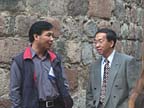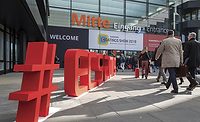
The conference auditorium was filled with a mixture of delegates from a wide range of industries, as well as several international universities. Presented by representatives from university research departments, start-up and ‘established' companies, the papers covered a wide range of new products and ideas on how to impart novel functions to paints and surface coatings.
Responding to Signals
The conference was opened by Prof. André Laschewsky (Fraunhofer Institute for Applied Polymer Research), who gave an excellent overview of the state of his and others' research into imparting reversible and irreversible switching properties to surfaces. Signals such as changes in temperature, pH and solvents cause the surface coating to respond by, for example, changing colour, form/structure or hydrophilic properties.Several papers dealt with specific developments in such systems. So it was that Prof. Lei Jiang (Chinese Academy of the Sciences) reported on surfaces that are coated with poly-N-isopropyl acrylamide (PNIPAAm) and laser structured, and that undergo reversible thermal switching from super-hydrophilic at 25 °C to super-hydrophobic at 40 °C. Dr. Stephen Bitler (Landec Corp.), presented coatings that, again controlled by the temperature, change their permeability to, e.g., CO2, and are already being used for foodstuffs packaging in the United States.
Polymers exhibiting shape memory were the focal point of the paper by Prof. Andreas Lendlein (mnemoscience). When heated, these polymers revert to a specific pre-programmed shape after they have been deformed at lower temperatures. Possible applications in the coatings area are "self-ironing" textile coatings or self-repairing systems.
Molecular Layers
Two papers by Dr. Andreas Voigt (Capsulution Nanoscience) and Prof. Nicolas Kotov (University of Michigan) were devoted to layer-by-layer (LBL) build-up of functional layers from polyelectrolytes. This technique is ideal for building up nano-layers, nano-colloids and micelles with very narrow particle size distributions and structures.
A Different View of Colour
The session on "Smart Colours" demonstrated the various ways in which colours can be created.Prof. Gion Calzaferri (University of Bern) reported on ways of selectively incorporating colourants into appropriate zeolites to produce highly effective colour antenna systems (fluorescent or colour-absorbing) that, despite their diversity, always look the same: many colours - one pigment (zeolite) chemistry.
Inverse opal layers are generated by Dr. Osamu Sato (Kanagawa Academy of Science & Technology) from monodisperse sub-micron polystyrene and nano-SiO2 particles. Application as film to substrate followed by pyrolysis produces a highly structured SiO2 layer that exhibits the colour of butterfly wings and is just as hydrophobic. When these layers are then incorporated into liquid crystals, photo-switchable structures are created.
Dr. Alberto Argoitia (Flex Products) demonstrated how magnetizable platelets can selectively align metal pigments with a previously engraved surface structure within the coating. This makes it possible to print holograms - and that opens up attractive applications in security printing.
UV Protection, Ultrabarriers and Polymeric Solar Cells
New applications were the focal point of the following session: Dr. Markus Pridohl (Degussa) demonstrated the use of nano-ZnO particles in highly effective UV protective coatings. Dr. Sabine Amberg-Schwab (Fraunhofer Institute for Silicates Research) reported on new organic-inorganic ultrabarrier layers that can protect highly sensitive solar cells or organic photodiodes against oxygen.
Solar cells based on polymers were the subject covered by Dr. Jens Hauch (Siemens). This electrical company has recently developed polymer-based photovoltaic cells that work with a light efficiency of 5%. This renders these systems commercially attractive for the first time.
For and Against Bacteria
The many possible applications of sol-gel-based multifunctional layers in medicine were discussed by Hermann Schirra (Sarastro). The primary goal here is obtaining a combination of antibacterial and easy-to-clean functions that these systems are capable of offering.
The exact opposite is being done by Prof. Michael Flickinger (University of Minnesota): he is incorporating porous coating systems permanently into living (genetically modified) bacteria. As reactor coatings, these "paints" are capable of producing desired chemical products, in the manner of a bacterial suspension in a fermenter, but much more effectively.


Report Abusive Comment